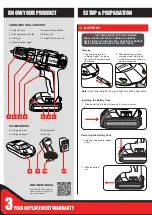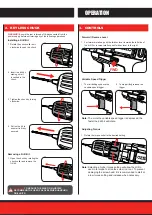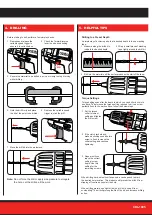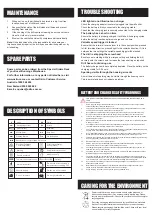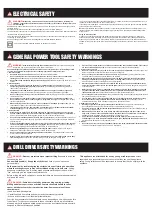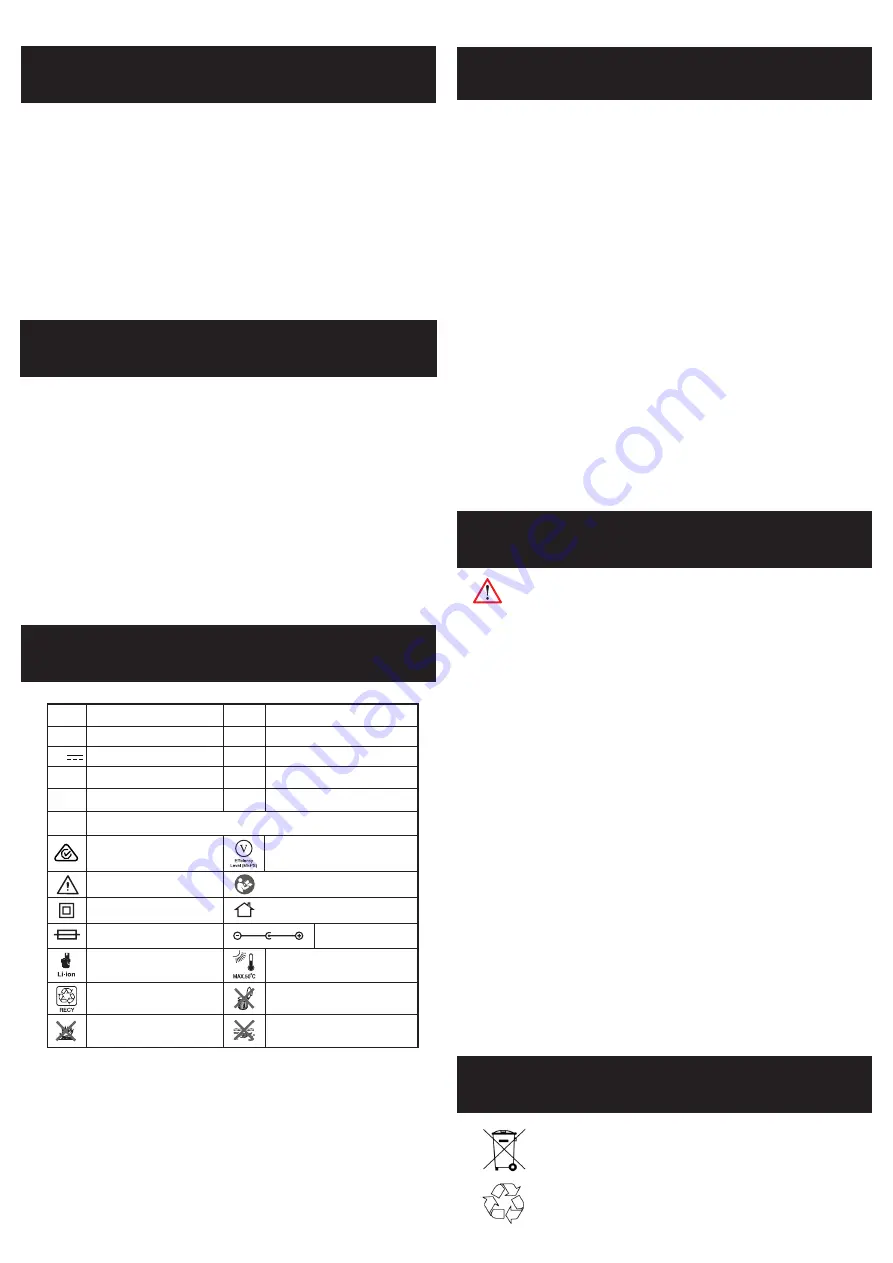
Power tools that are no longer usable should not be disposed of
with household waste but in an environmentally friendly way. Please
recycle where facilities exist. Check with your local council authority for
recycling advice.
Recycling packaging reduces the need for landfill and raw materials.
Reuse of recycled material decreases pollution in the environment.
Please recycle packaging where facilities exist. Check with your local
council authority for recycling advice.
MAINTENANCE
DESCRIPTION OF SYMBOLS
CARING FOR THE ENVIRONMENT
TROUBLESHOOTING
1. When not in use, the drill should be stored in a dry, frost free
location, keep out of children’s reach.
2. Keep ventilation slots of the drill clean at all times and prevent
anything from entering.
3. If the housing of the drill requires cleaning, do not use solvents.
Use of a cloth only is recommended.
4. Blow out the ventilation slots with compressed air periodically .
Note:
Ozito Industries will not be responsible for any damage or
injuries caused by repair of the drill by an unauthorised person or by
mishandling.
Spare parts can be ordered from the Special Orders Desk
at your local Bunnings Warehouse.
For further information, or any parts not listed here, visit
www.ozito.com.au or contact Ozito Customer Service:
Australia 1800 069 486
New Zealand 0508 069 486
E-mail: enquires@ozito.com.au
SPARE PARTS
BATTERY AND CHARGER SAFETY WARNINGS
THIS MANUAL CONTAINS IMPORTANT SAFETY AND OPERATING INSTRUCTIONS FOR
YOUR
BATTERY CHARGER.
1.
Before using the charger read all instructions and cautionary markings on the charger, battery
pack and the product using the battery pack.
2.
This charger is not intended for any uses other than charging rechargeable batteries. Any other
use may result in risk of fire, electric shock or electrocution.
3.
Do not place any object on top of the charger or place the charger on a soft surface that may
result in excessive internal heat. Place the charger in a position away from any heat source.
4.
To reduce risk of damage to the electric plug and cord, pull by the plug rather than the cord when
disconnecting the charger.
5.
Make sure the cord is located so that it will not be stepped on, tripped over, or otherwise subjected
to damage or stress.
6.
An extension cord should not be used unless absolutely necessary. Use of an improper extension
cord could result in the risk of fire, electric shock or electrocution.
7.
Do not operate the charger if it has received a sharp blow, been dropped or otherwise damaged in
any way. Have it checked by an electrician or power tool repairer.
8.
Do not disassemble charger. Take it to an electrician or power tool repairer when service or repair
is required. Incorrect reassembly may result in a risk of electric shock, electrocution or fire.
9.
To reduce risk of electric shock, unplug the charger from the outlet before attempting any cleaning.
Removing the battery pack will not reduce this risk.
10.
Never attempt to connect 2 chargers together.
11.
DO NOT store or use the tool and battery pack in locations where the temperature may reach or
exceed 40ºC (such as inside sheds or metal buildings in summer).
12.
The charger is designed to operate on standard household electrical power (240 volts). Do not
attempt to use it on any other voltage!
13.
The battery pack is not fully charged out of the carton. First read the safety instructions and then
follow the charging notes and procedures.
14.
The longest life and best performance can be obtained if the battery pack is charged when the
air temperature is between 18 - 24ºC. Do not charge the battery pack in an air temperature below
10ºC or above 40ºC. This is important and will prevent damage to the battery pack.
15.
Do not incinerate the battery pack even if it is seriously damaged or is completely worn out. The
battery can explode in a fire.
16.
Never attempt to open the battery pack for any reason. If the plastic housing of the battery pack
breaks or cracks, immediately discontinue use and do not recharge.
17.
During charging, the battery must be placed in a well ventilated area.
LED lights do not illuminate on charger
Check the charging adaptor is securely plugged into the wall outlet.
Check the battery is firmly connected to the charging cradle.
Check that the charging jack is securely connected to the charging cradle.
The battery has a short run time
Ensure the battery is properly charged. It will take 4-5 charging cycles
before the battery reaches optimum charge and run time.
Variable speed trigger is locked
Ensure that the forward / reverse lever is in the correct position; pressed
left for forwards direction, pressed right for backwards direction. If it is in
between the two settings the variable speed trigger will be locked.
The drill is stripping the screw head
Ensure you are starting with a low torque setting and holding the drill
securely onto the screw head. Increase the torque setting as required.
Drill has cut out during use
The battery charge could be completely depleted. Place the battery on the
charging cradle for 3-5 hours.
Sparking visible through the housing air vents
A small amount of sparking may be visible through the housing vents.
This is normal and does not indicate a problem.
Warning
Read instruction manual
ø
Diameter
mA
Milliamperes
Recycle battery
Do not put in the rubbish
Polarity
Do not incinerate
Do not get battery wet
Thermal cut-out protection
Transformer Energy
Rating (MEPS)
Double insulated
/min
Revolutions or reciprocation per minute
Ah
Amp hour
Indoor use only
Lithium Ion battery
Do not use or store battery in
temperatures exceeding 50°C
Electrical Emissions
Conformity (EMC)
Nm
Newton Meters
n
o
No load speed
V
Volts
Hz
Hertz
ac/~
Alternating current
W
Watts
Direct current
dc/


